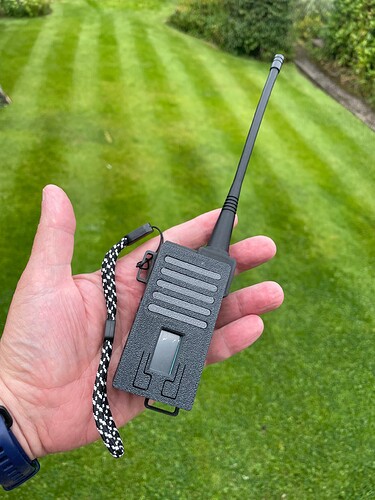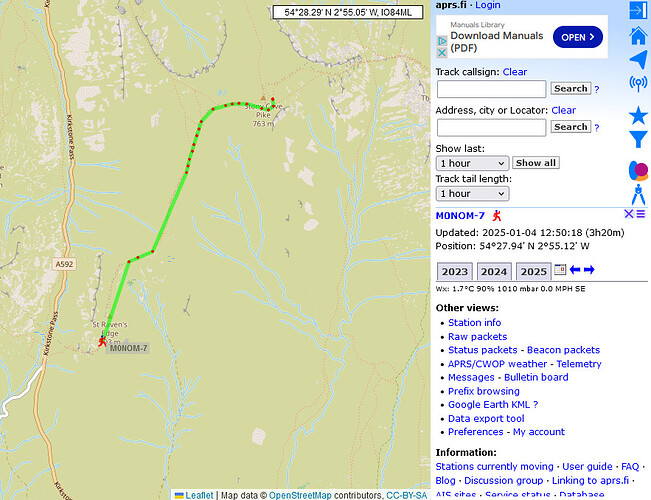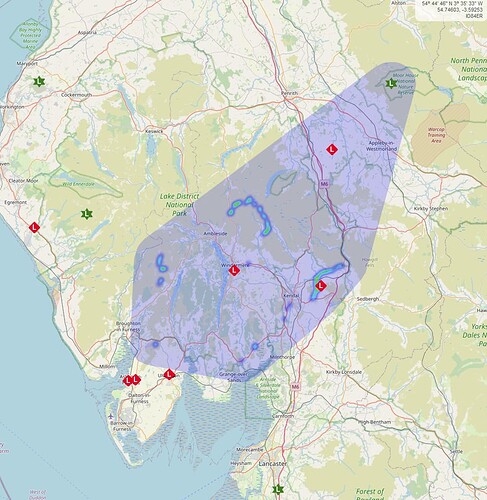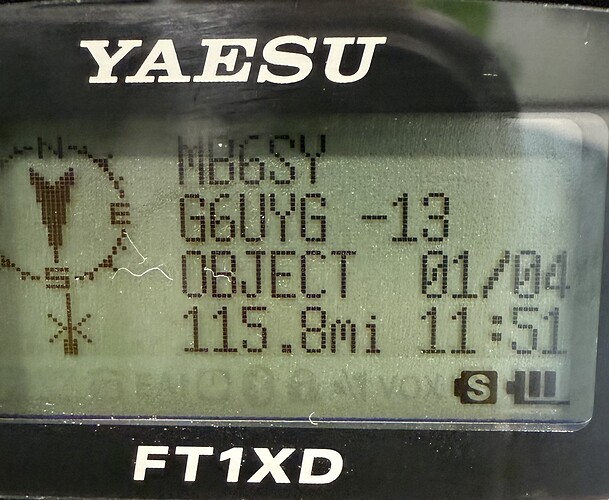For those of you not following trends on the SOTA Reflector I’d like to bring to your attention the groundswell that is currently happening in the area of LoRa APRS Tracking in the Lake District.
Lets define a couple of things here. For those of you who don’t know what APRS is, here’s a succinct definition.
What is APRS?
APRS (Automatic Packet Reporting System) is a digital communication protocol used by amateur radio operators to send real-time data such as GPS positions, weather reports, and messages over radio frequencies. It works by sending small “packets” of information that are relayed through a network of digipeaters (repeater stations) to other operators and monitoring systems. APRS can be used for things like tracking the location of vehicles, boats, or people, as well as sharing weather data or brief messages, all using relatively simple equipment like a transceiver, a GPS, and a TNC (Terminal Node Controller) or integrated software. It relies on the presence of a local APRS infrastructure to propagate the data, which can be received by anyone with the appropriate receiver.
What are the benefits of APRS to portable radio operators
So I turn on my FT1XD and set it up to broadcast APRS packets on 144.800 FM. It uses VFO-B to achieve this. You can set the radio to broadcast an APRS packet every 5 minutes, or use Smart Beaconing which only broadcasts whist I’m moving. My broadcast will include my APRS identifier, GPS position and altitude.
Where one of my APRS packets is picked up by a station with a radio connected to the internet, my track will appear on aggregation sites like aprs.fi. By convention /P operators will have an APRS identifier with a -7 suffice, such as M0NOM-7.
APRS support in traditional Radios
APRS is supported by some manufacturers of radios, for example the Yaesu FT1DX handheld or their higher end 2m/70cm mobile radios.
Point-to-point communication via traditional RF APRS is reasonably common in the Lake District. Tuning your radio to 144.800 (the 2m FM APRS frequency) whilst on the fells will generally pick up APRS transmissions from portable operators, people driving in the area with mobile rigs broadcasing APRS packets, and the occassional base station.
APRS takeup in the Lake District
The issue with APRS takeup in the Lake District is that there are not many base stations connected to the internet that have coverage of the Lake District. This is probably due to a combination of the cost of APRS supporting radios, dedicating an antenna and radio to APRS, and the technical challenges of getting it all connected reliably to the internet. As a result coverage is poor.
What is LoRa?
LoRa (Long Range) is a wireless communication technology designed for long-distance, low-power transmissions, typically used in the Internet of Things (IoT) applications. It allows devices to send small amounts of data over several kilometers, even in remote areas, using very little power. LoRa works by using a special modulation technique that lets signals travel farther than typical Wi-Fi or Bluetooth, making it ideal for applications like remote sensors, tracking devices, and smart agriculture. Unlike traditional radios, LoRa networks are often set up in a star topology, with devices communicating directly to central gateways, which then connect to the internet or other networks. Its low power consumption means devices can run for years on small batteries, making it a great choice for outdoor or off-grid use.
How is LoRa technology being used to support APRS
APRS can be supported by LoRa technology by combining the real-time data transmission capabilities of APRS with the long-range, low-power features of LoRa. In this setup, devices equipped with LoRa radios can send APRS-style packets (such as GPS coordinates, weather data, or status messages) over much longer distances than typical VHF/UHF APRS transmissions. Instead of relying on traditional APRS infrastructure, like repeaters and digipeaters, LoRa can be used to create a private or wide-area network, where LoRa gateways (which act like digipeaters) receive and forward the APRS packets to other gateways or central systems.
LoRa-based APRS systems can be especially useful in remote areas where traditional APRS infrastructure (like repeaters) isn’t available, or when operators want to reduce power consumption. These systems usually work by using a LoRa-based radio module in conjunction with APRS software, allowing data to be transmitted efficiently over long distances with minimal power requirements. This integration opens up new possibilities for real-time tracking, messaging, and data exchange in areas with limited or no access to conventional APRS networks.
So how does this work in reality?
As an activator, you need a dedicated tracker device.
This consists of a single PCB containing a LoRa transmitter and receiver, GPS module, Arduino controller and display. Dave Pegler, M0JKS, a SOTA operator, has created an excellent 3D printed case (shown in photo) to enclose the PCB together with an antenna, battery and charging dock. As the technology is very power-efficient, the internal battery lasts for days. The tracker is very light. Although these devices only put out 100mw, because of the very efficient modulation communication distances of 50km and more are not uncommon. Once configured, the tracker broadcasts once every 5 mins or so whilst turned on. It’s a simple as that. You turn it on, clip it to your rucksack, and forget about it.
There are a number of bands/frequencies supported by LoRa technology, but for APRS support in the Lake District (and other regions) the majority of operators use 70cm, with a specific frequency being used 439.912500 Mhz. The devices comply with Ofcom regulations.
A typical LoRa PCB that includes GPS and a display can be bought via AliExpress for £25. The case with battery and dock costs just over £20.
Base Stations/iGates
An iGate is an internet-connected LoRa device, programmed to receive APRS packets transmitted by trackers and forward them on to the internet.
The good news is that there are a number of amateur radio operators who have set up base stations, or iGates, that now provide good coverage of the Lake District for portable operators on the fells. Nigel M5TUE based in Docker (between Kendal and Sedburg) has a dedicated iGate with antenna directed towards the South Lakes. Nick G0HIK based near Askam has two iGates now running. Matthew M0MZB has gone one further and installed an iGate on Seatallan that is solar powered, with obviously excellent coverage.
As iGates do not require displays or GPS the PCBs are typically cheaper - I bought the same as Nigel and it was just over £10. They have built in WiFi so once configured you plug them into an antenna and leave them running, powered via USB. Antenna choice could simply be a cheap 70cm magmount or mobile antenna, or a 70cm supporting vertical or yagi. I’ve connected my LoRa module to my Diamond X50 main VHF/UHF antenna, using an antenna switch between the module and my VHF/UHF rig. In the long term I plan to install a dedicated antenna.
On my activation or Stony Cove Pike today you can see my progress once I had reached St Raven’s Ridge. This allows chasers to track progress of an activator. It also allows family and friends to have an idea where you are too.
I’m still very new to all this, although I’ve used APRS in the past. The benefit of using APRS via LoRa technology is primarily the reduction in cost, but also leverages the LoRa mode to maximise distances.
Mark. M0NOM




